Rose is an unusually luxurious flower that combines the unique beauty and magic of heady aromas. It has long been used to decorate palaces and parks with roses; their oils have been added to soaps, cosmetics and perfumes. Nowadays, this royal plant is available to every amateur gardener. The assortment includes more than 150 types of garden rose groups. Plant seedlings should be selected based on climatic conditions.

Climbing roses, without exaggeration, are the best way to vertically plant a garden.
Reasons to use climbing roses in landscaping
Content
- Reasons to use climbing roses in landscaping
- How beautiful to arrange a rose garden in the country
- Flower bed decoration
- Combination with other colors
- Vertical rose garden in landscape
- Wood as a support for a climbing rose
- Garter of climbing roses to supports
- Forming a bush in the form of a fan
- Planting, leaving, preparing for winter
- Video: Climbing roses in the summer in the country
- Photo examples of the use of climbing roses for garden decoration
Climbing varieties of roses will create a shady oasis in a hot garden, will be a wonderful decoration for gazebos, arches, verandas or fences. They hide well all the errors of buildings and unaesthetic moments. Intertwining roses reach a height of 4 m and are distinguished by very beautiful, large and velvety buds: climbers, ramblers. Such varieties are the result of selection work on crossing wild and garden breeds.
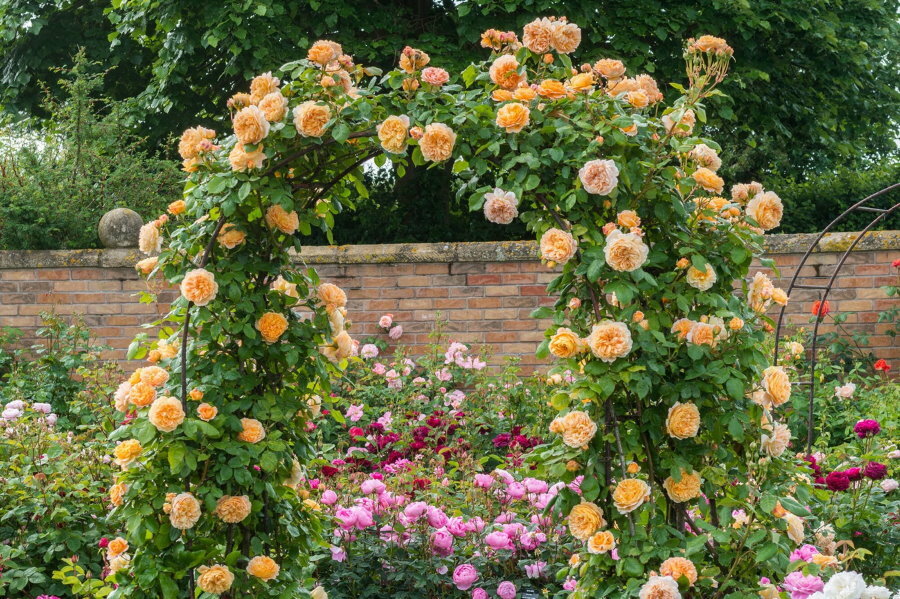
The grace of the loops and the abundant flowering of climbing roses are little comparable
This species is distinguished by arcuate whip-like shoots that need a rigid vertical support. They please with their flowering for 30 days, but some varieties have a repeated flowering phase.
Depending on the species, there are flowers of various colors: from pink to red, from yellow to salmon pink, from cream to snow-white.
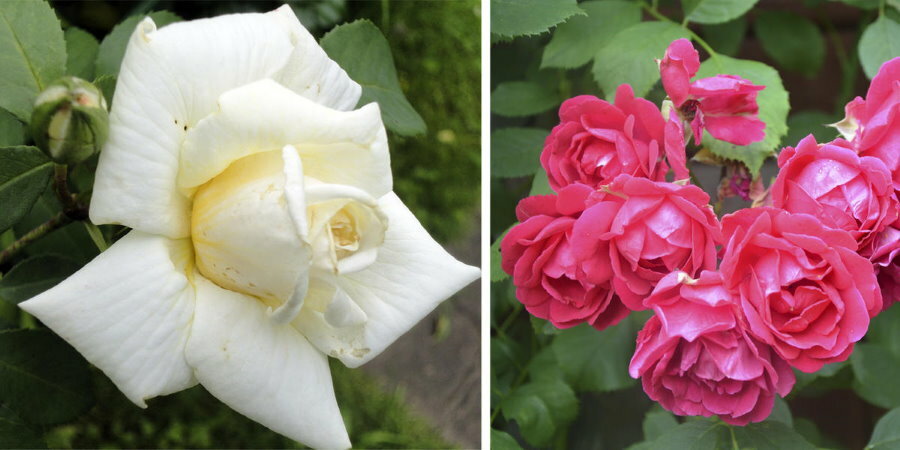
In the photo you can see how different inflorescences are in shape, size and color.
How beautiful to arrange a rose garden in the country
You can use various varieties to create a landscape, but collecting more than three is not worth it, so as not to get lost among the roses in the garden design. The main task is to create a harmonious and colorful flower garden. A combination of several types will form the proper decorative effect.
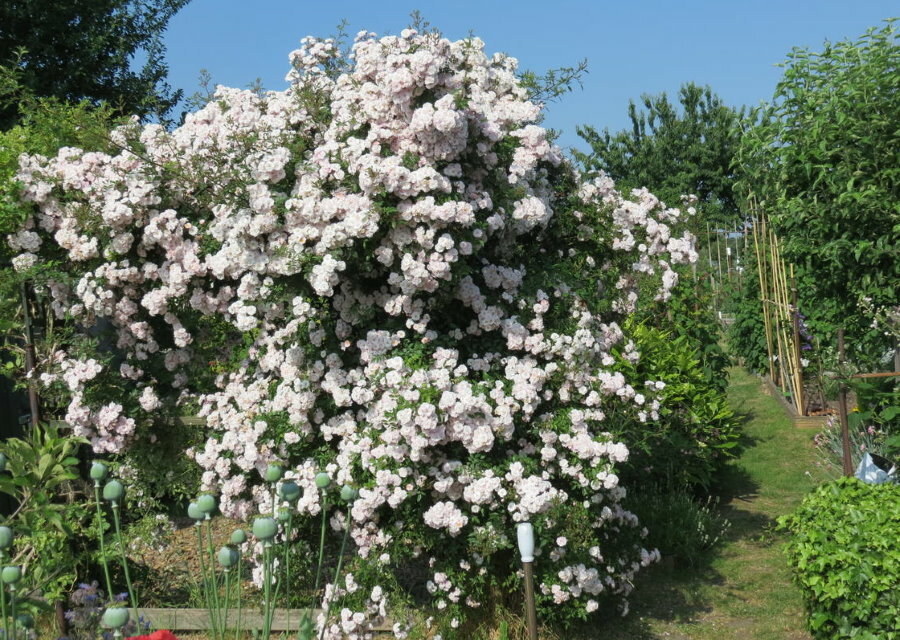
A climbing rose will easily make the garden attractive, even when planted as a single copy.
Flower bed decoration
The place for the flower bed should be well lit and windless. The optimal solution is partial shade to the south. For its arrangement, more space is needed than for a vertical rose garden. It is worth using a small curb of low-growing evergreen shrubs.
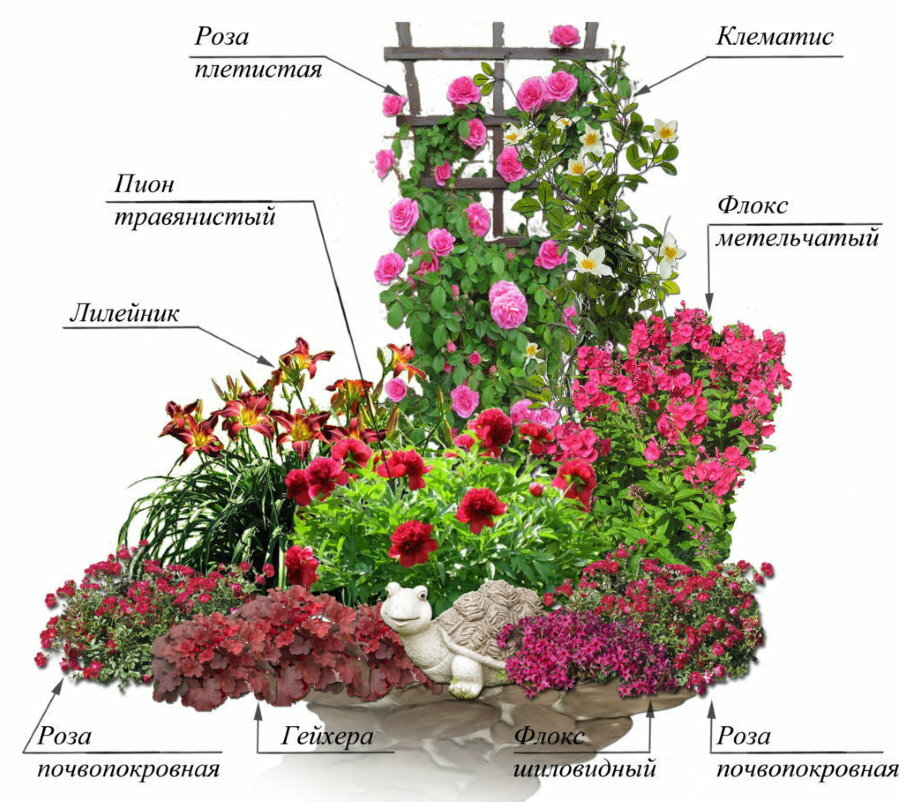
An example of a successful selection of flowering plants for a flower bed with a climbing rose
When choosing a place for a flower bed, it is worth considering its scale. Plants are selected in shape and height. Roses are planted separately or in bulky groups. Polyanthus roses are most often placed in the foreground, and remontant, tea or park varieties will look spectacular in the background.
For the normal development of flowers, you need sun for at least 6 hours a day and shade for at least 3 hours a day.
Climbing rose in the garden photo site design:
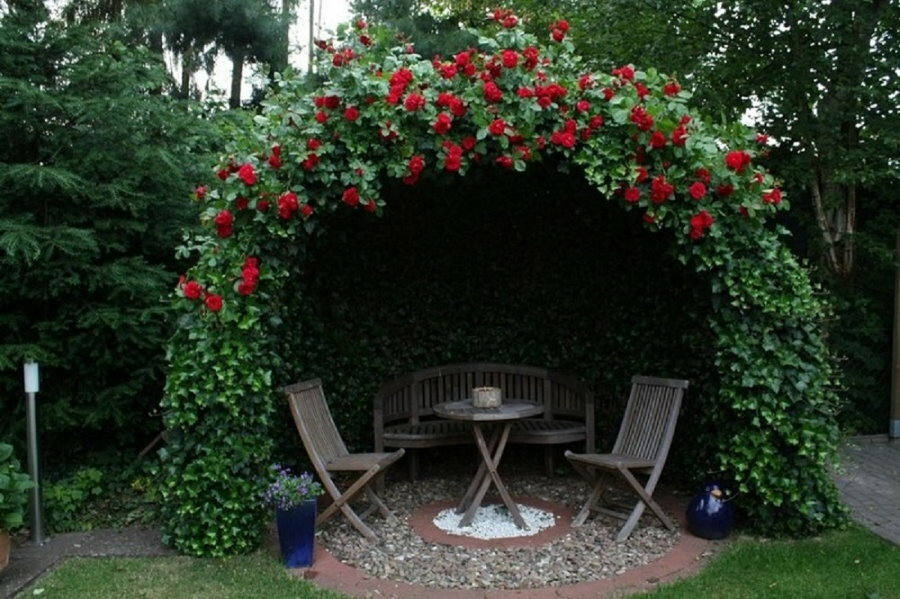
A cozy gazebo created by lashes of roses curling along the metal frame of the pergola
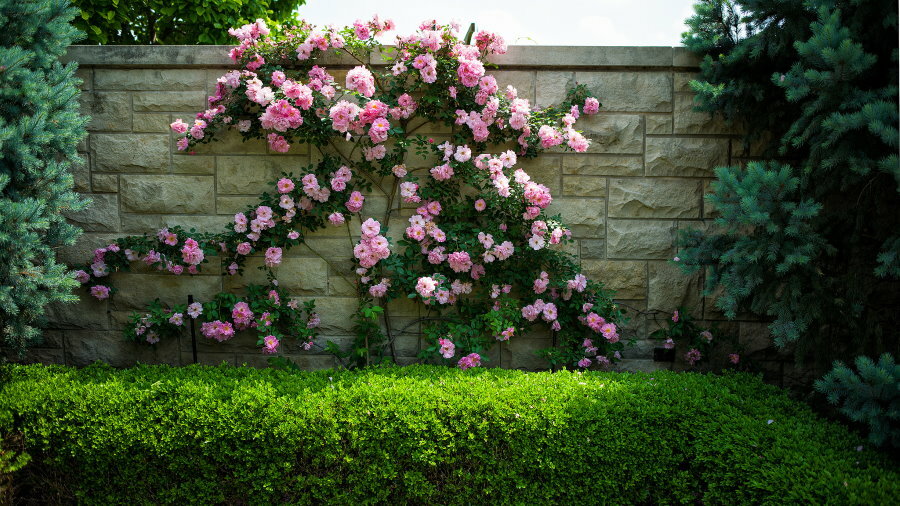
For a spectacular decoration of a section of a stone fence between the trees, only one bush of a climbing rose was enough
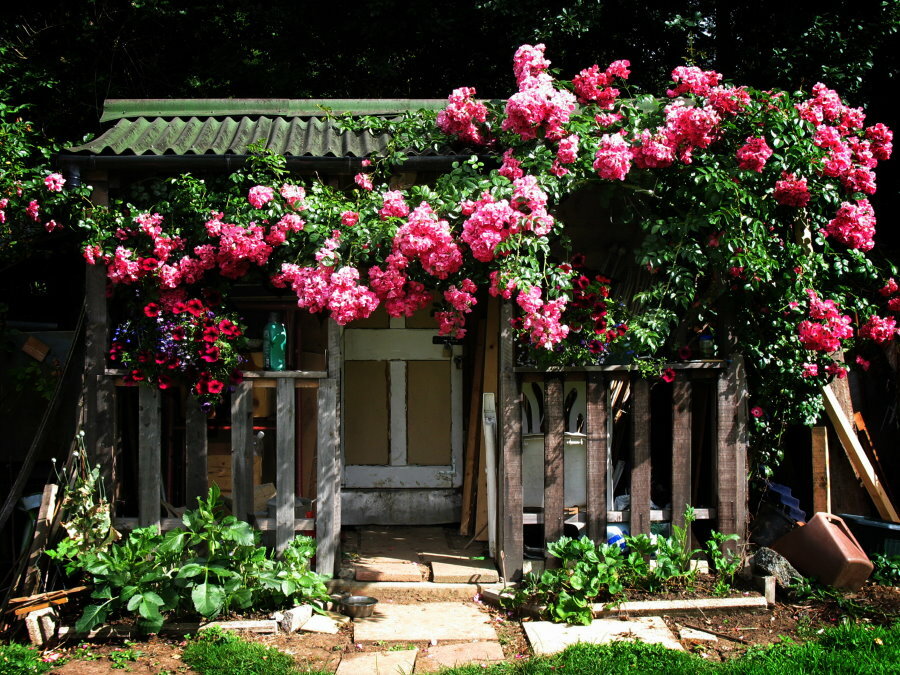
Climbing roses are the best suited for a small garden, because when planting they take up very little space
Combination with other colors
Clematis and daylily are considered the best friends of this flower. Rose and clematis are an excellent tandem not only in terms of decor, but also agrotechnical requirements for growing. The daylily is unpretentious and looks great in the compositions of the rosarium.
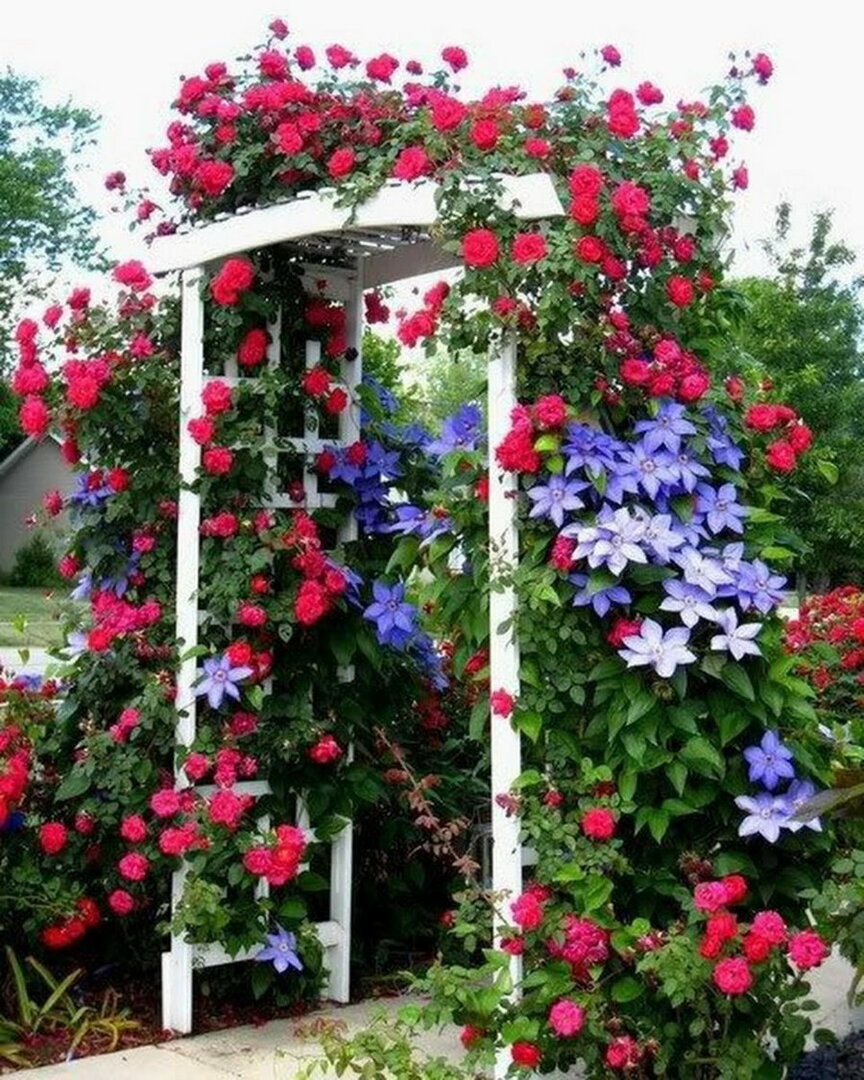
Clematis are the most popular neighbors of climbing roses
The companions of the owner of the garden include sage, delphinium, foxglove, bells, burnet, asparagus, acoint.
The color environment of the queen is chosen according to the frequency and duration of flowering, according to plant height and size, color contrast.
The most popular neighbors of the rose garden:
- Spring bulbous flowers and perennials.
- Decorative leafy species are an excellent mix.
- Climbing roses are often combined in landscape design with perennials and complemented with multi-flowered species.
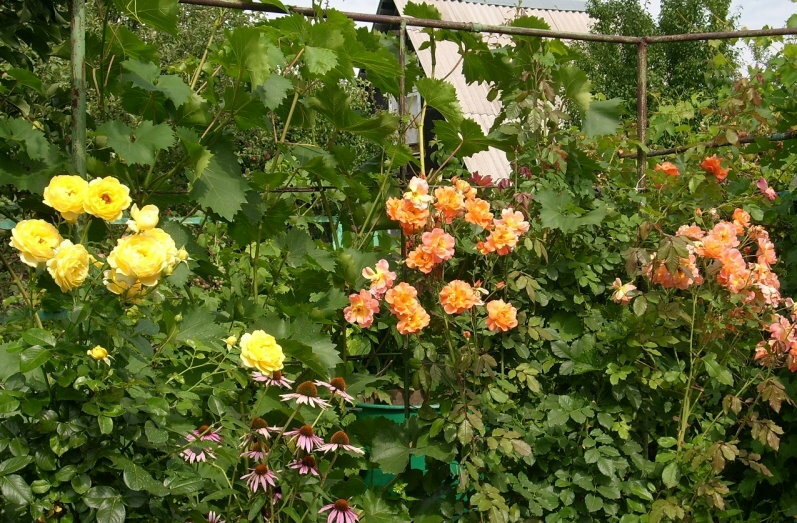
An interesting combination of climbing roses with grapes
Vertical rose garden in landscape
Climbing roses grow best near buildings, as they need support and cling to the facade of buildings. A vertical rose garden can be arranged anywhere in the summer cottage, but this will require arches or decorative partitions. They look great in combination with gazebos, which makes them sophisticated and mysterious.
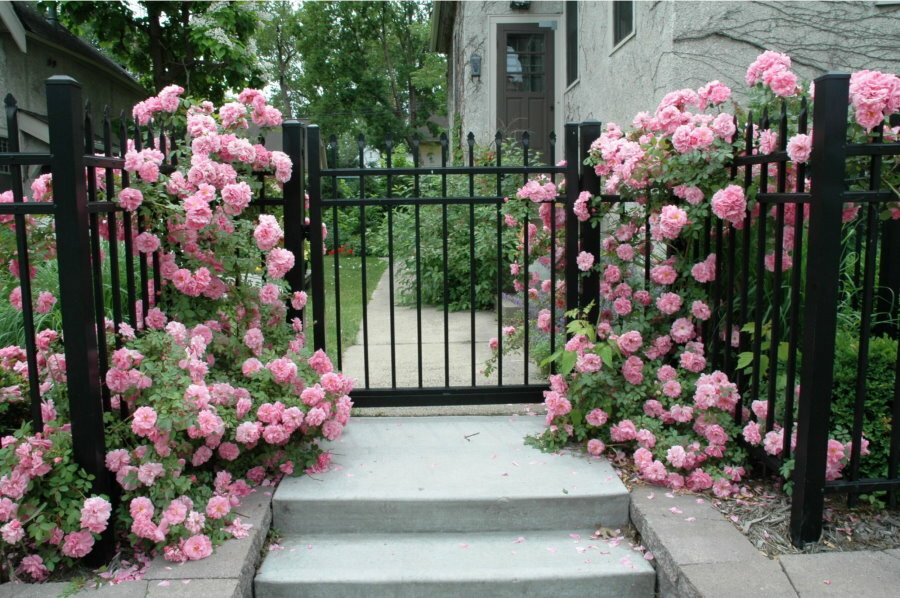
Climbing roses are good everywhere - on a fence, arch, column or gazebo
Varieties of roses with rich flowering are very fond of water and grow well near fountains and reservoirs, so they are often used as a decorative hedge. Most often, the vertical rose garden is decorated in classic colors: white, pink, salmon shades and red. Here you can combine all the techniques and make any fantasy come true.
Climbing roses in landscape design photo:
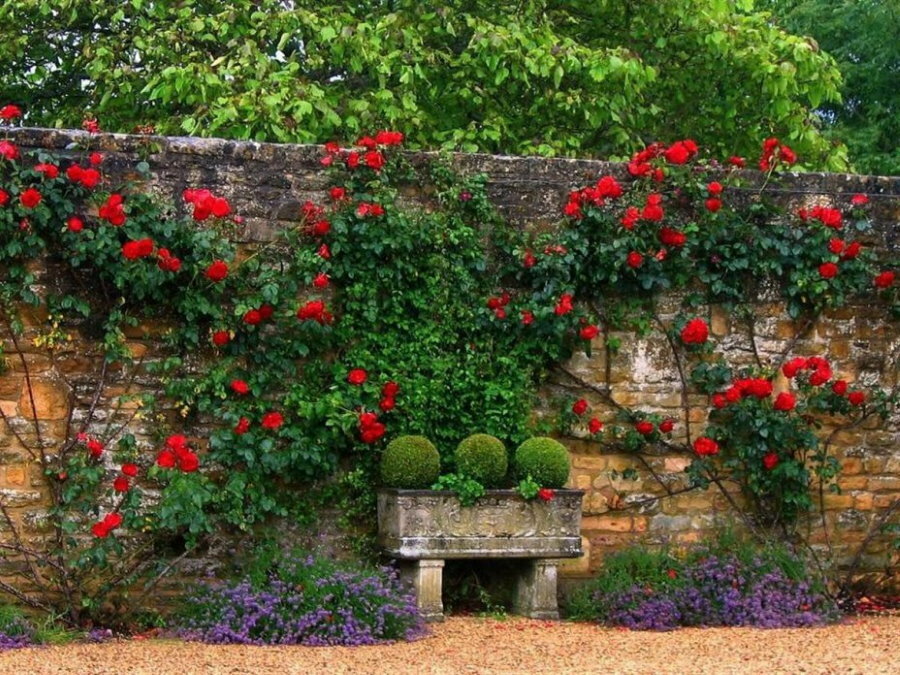
Decorating brick walls with roses is a very common technique in landscape design.
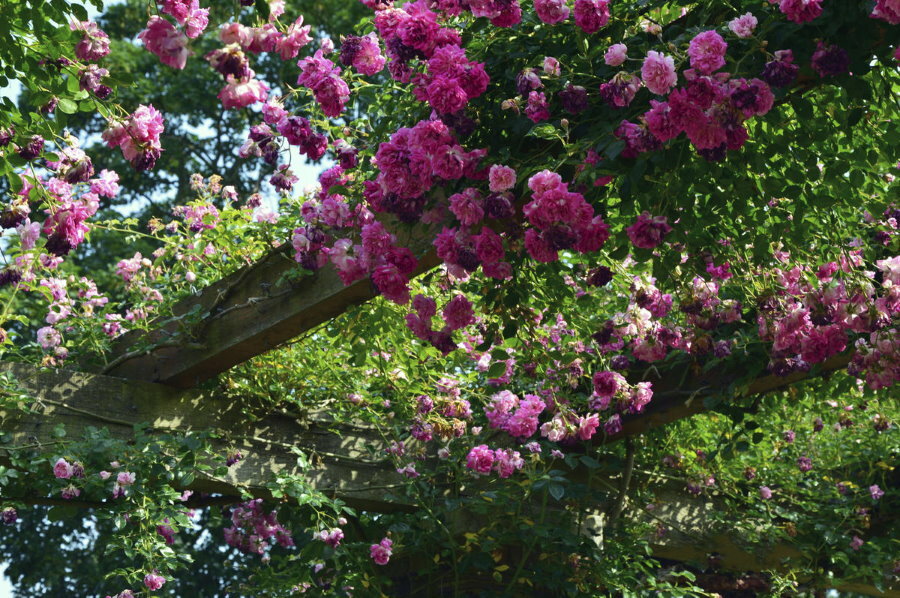
Another popular solution is to use a rose to decorate a garden arch.
Wood as a support for a climbing rose
These varieties will perfectly hide all the imperfections of buildings, and also turn unsightly dead wood into a work of art. So, for example, in order not to uproot a dried tree, it can be decorated with climbing roses, for which it will serve as a vertical support.
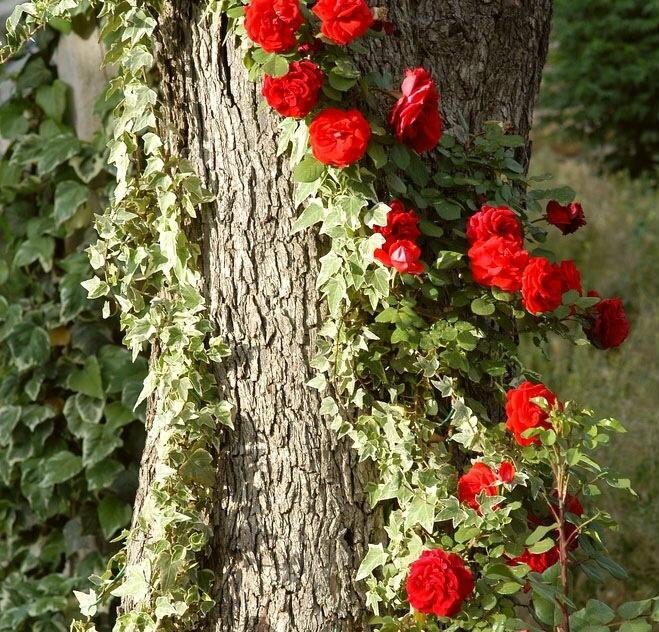
An old tree as a support for a climbing rose
Garter of climbing roses to supports
The vertical rose garden needs constant maintenance. Branches of weaving varieties are constantly knocked out of the general ensemble and twisted in different directions, looking for a support that you can catch on to. Therefore, they must be tied up all the time and adjusted in the right direction, and large stems-lashes must be fixed on strong vertical supports.
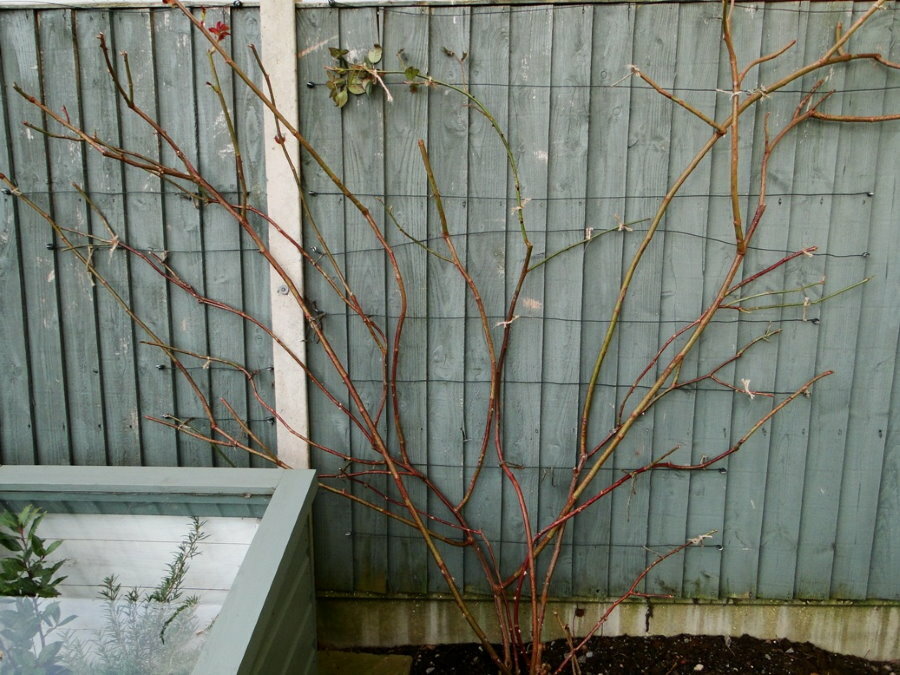
The garter of the branches of a climbing rose depends on the method of forming the bush.
Forming a bush in the form of a fan
Flower garlands of roses will create a fabulous atmosphere in the country. The bush, decorated with the help of special supports in the form of a fan, looks quite original.
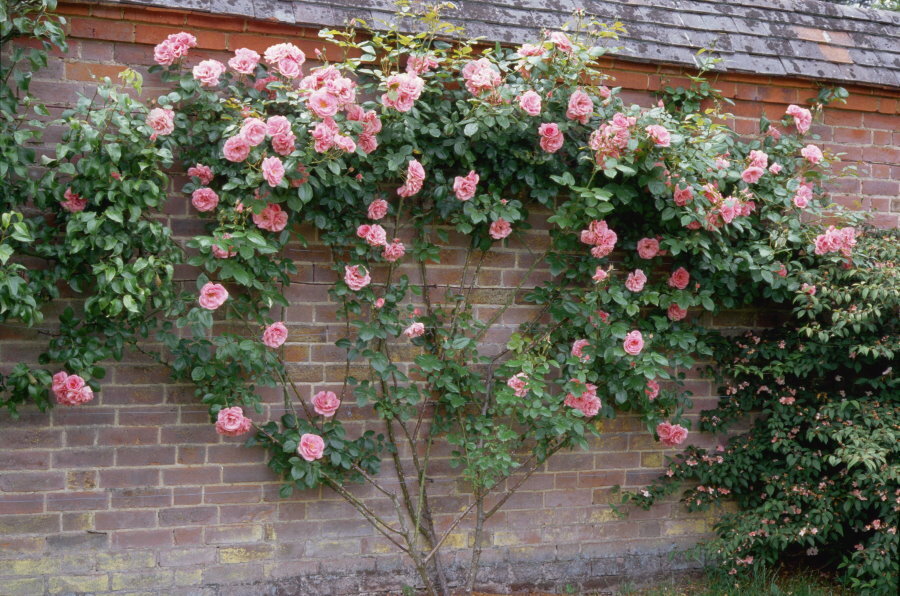
It is quite simple to arrange in the form of a fan a rose bush, planted near some kind of solid support
Often in parks and gardens you can find chic and bewitching beauty compositions of evergreen shrubs that are trimmed in the shape of a peacock's body, and the tail of roses is decorated with this technology.
Climbing Rose Gardens:
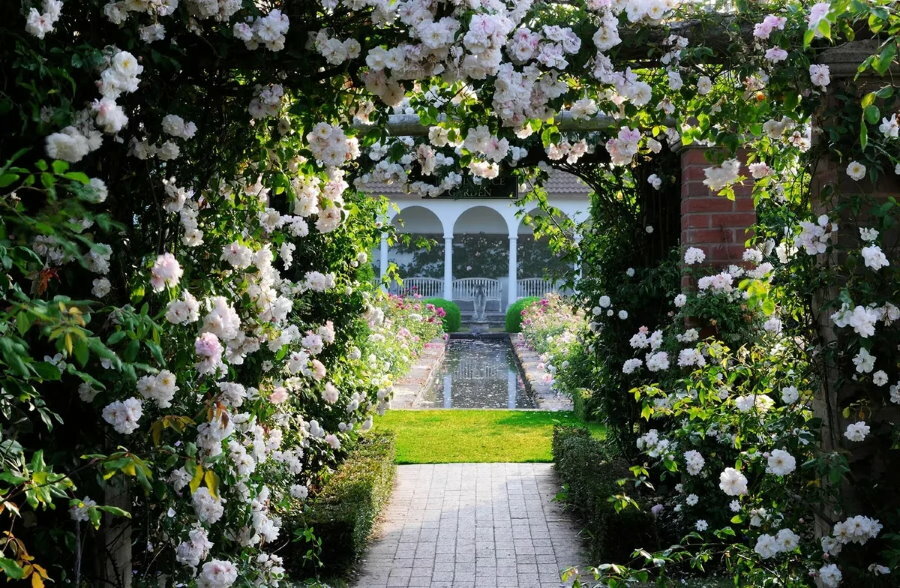
Small-flowered varieties of roses are best suited for pergolas and columns.
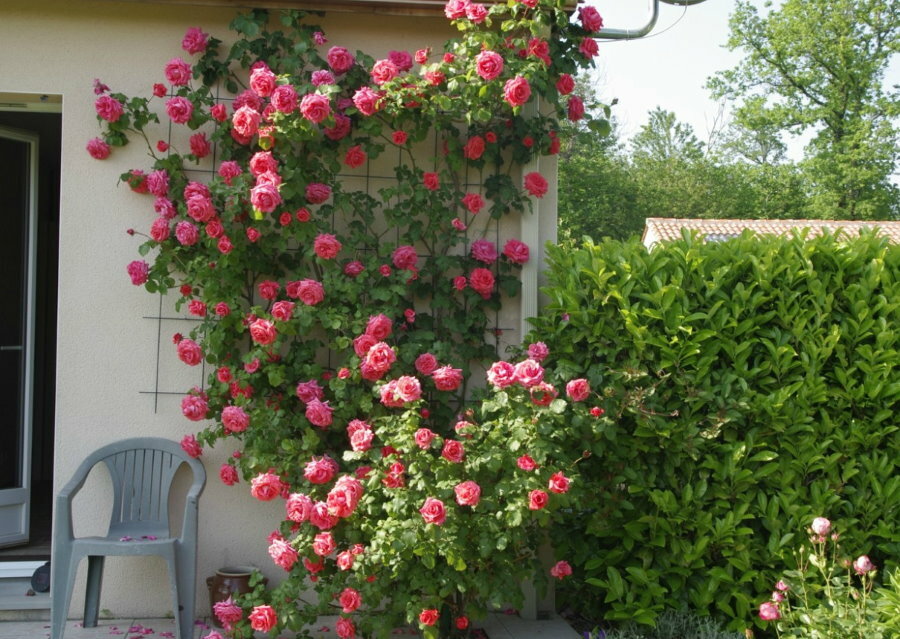
Roses with large flowers are planted on trellises or along walls
Planting, leaving, preparing for winter
Spring and autumn are most favorable for planting roses. In the autumn months, they adapt better after planting, and in the spring they begin to grow and develop rapidly.
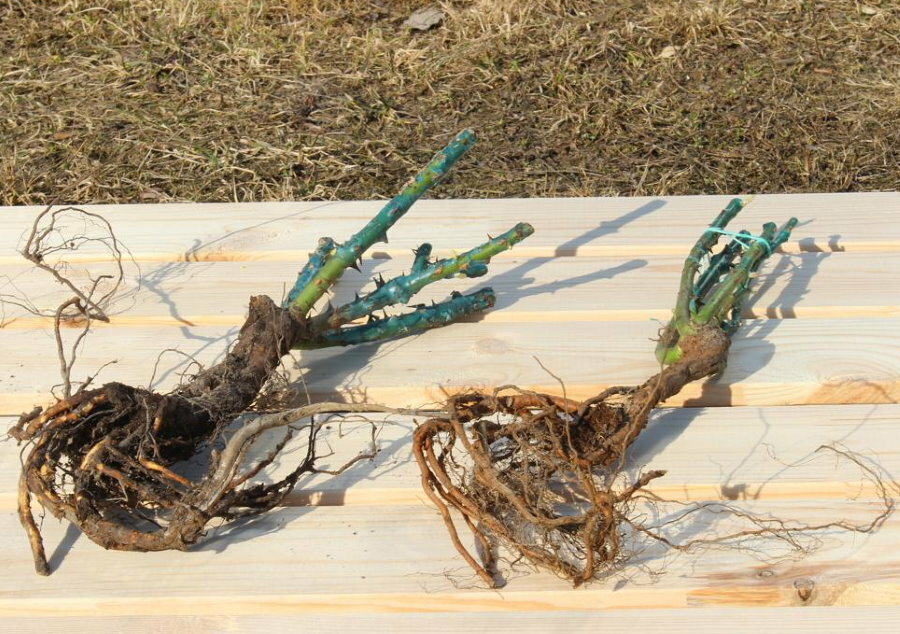
Planting climbing roses begins with the acquisition of high-quality seedlings
When landing, the normal air temperature is from +1 to +7 degrees. It is better to choose a sunny place, then the rose will form buds abundantly. If the plant is planted in the shade, it loses its strength and at first the bushes will grow, but there will be few flowers, and over time they may completely disappear. However, weaving varieties are an exception to the rule - they tolerate shade well.
Landing technology:
- In a few days, prepare the soil and holes for planting. The soil is cleaned of weeds and must be loosened well - it should be light, moist and breathable.
- The distance between the holes should be about 40 cm. When a bush grows about 1 m, it is important to take into account the plant variety - for large bushes, the distance should be increased. Roses planted too close can start to hurt and there will be problems in care when the bush grows.
- A few days before planting, holes are prepared with a size of 50 x 50 and a depth of 60 cm, filled with abundant water. After absorbing water, pebbles or a special mass are laid out on the bottom of the hole to create good drainage for the plant.
- The next layer is laid out with fertile soil: organic fertilizers - humus, compost with ordinary soil or manure.
- Preparation and inspection of the bush: examine the roots, if dry, soak for several hours. Prune long roots up to 25-35 cm and remove broken shoots and update existing cuts.
- The bush is planted so that the grafting site is 10-15 cm under a layer of soil, the roots are well spread over the hole.
- After planting, the flower is abundantly watered.
Highlights of rose care:
- Abundant watering - once or twice a week, taking into account climatic conditions and weather.
- Obligatory loosening of the soil several times a week - the soil should be light.
- When pests or fungal diseases appear, treat the bushes with special solutions.
- Once a year, in the spring before the buds appear, pruning is done.
- Timely fertilizing with fertilizers.
The queen of flowers does not like cold and harsh winters. For the northern regions, special frost-resistant varieties bred by breeders are suitable.
Before the arrival of cold weather, the soil around the bush is dug in, the shoots of roses are bent to the soil and laid on an interlayer of spruce branches. Then a mound of dry earth up to 30 cm is poured around the base of the bush. It is undesirable to use peat, sawdust or sand - this can cause an ice crust to form and injure the plant.
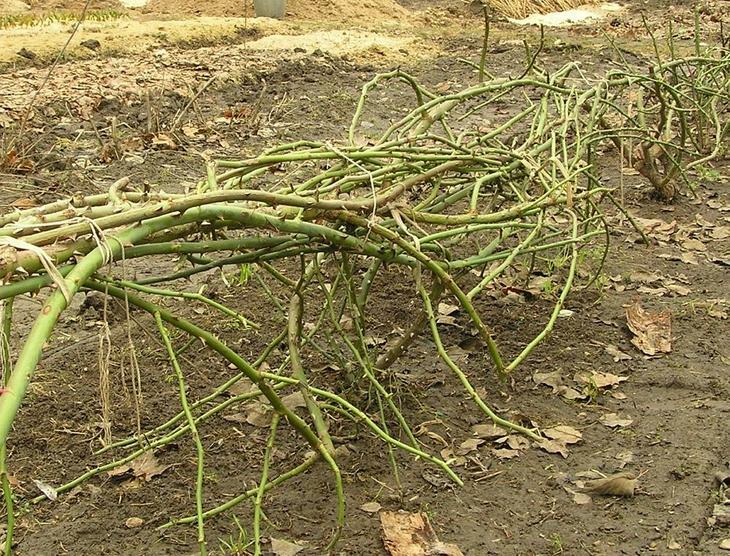
Too long branches are cut, bent to the ground and tied
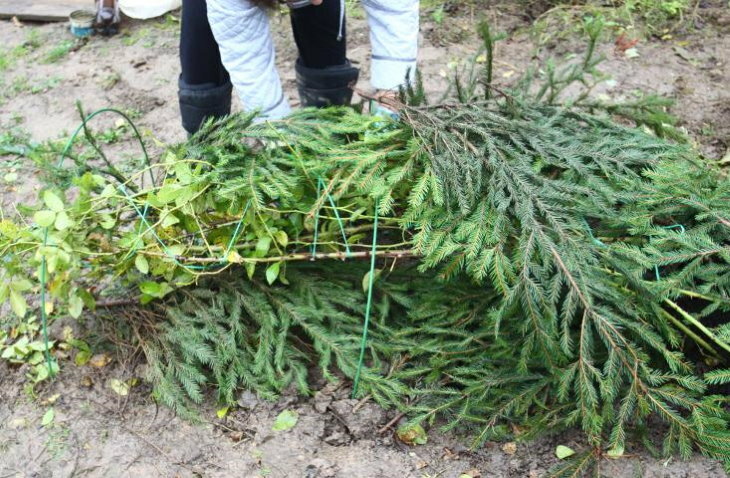
Shelter with spruce branches allows you to create optimal conditions for wintering
With the onset of frost, the bushes are covered from above under frames with a height of 50-60 cm made of insulation materials: waterproofing paper, cardboard, glassine, plastic film. The end sides are closed when the frost is below 10 degrees.

The ends of the shelter can be closed only during the onset of frost
Video: Climbing roses in the summer in the country
Photo examples of the use of climbing roses for garden decoration
Roses are welcome guests on any site, from them you can create both small flower beds and chic rose gardens. It is enough to decide on the right planting site, choose the right varieties and beautifully design the idea of the composition.



